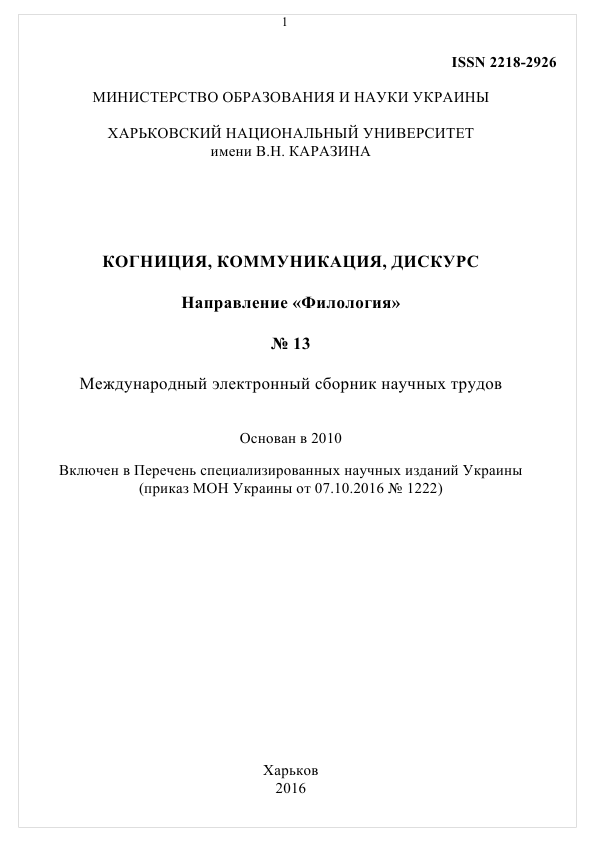Text in metatext (on the material of small form genres)
Abstract
The article investigates different types and methods of text metadescription, so-called self characterised texts. Self characteristics (metadescription) of the text and the genre it presents may be in the text itself, as well as in the adjacent description. The former method is inherent to small genres, such as aphorism, proverb, fable, fairy tale, anecdote, etc.; the latter method is applied mainly to more expanded texts in the form of introductions, comments, and afterwords. The article aims to create a matrix of different kinds/methods of verbal self characteristics of texts of various genres, concentrated in metatext. The process of self-realization of the genre that a text features have been studied in the paper. These kinds of self characteristics genre don not make a comprehensive list; moreover, there can be a metatext of a different form, wherein the genre self characteristics is concentrated.
Downloads
References
Berthel, G. (Ed.). (1989). Kurz und mündig: Aphorismen. Rudolstadt: Greifenverlag.
Beyer, H., & Beyer, A. (Eds.). (1988). Sprichwörterlexikon. Sprichwörter und sprichwörtliche. Ausdrücke aus deutschen Sammlungen vom 16. Jahrhundert bis zur Gegenwart. Leipzig: VEB.
Dal, V. (1879). Poslovitsy russkogo naroda [Proverbs of the Russian folk]. St. Petersburg and Moscow: M.O. Wolf Publ. Enzensberger, M. (Ed.). (2003). Die Hölderlin Ameisen. Cologne: DuMont Kunst- und Literaturverlag.
Gorelov, A. (2007). Russkaya chastushka [Russian humorous rhyme]. St. Petersburg: Azbukaklassika Publ.
Pichtownikowa, L. (2008). Synergie des Fabelstils: Die deutsche Versfabel vom 13. – 21. Jahrhundert (Band 5). Aachen: Shaker Verlag.
Pikhtovnikova, L. (2000). Evolutsiya nimetskoi virshovanoi baiky: Zhanrovo-stylistychni aspekty [Evolution of the German Poem Fable: Genre and stylistics aspects]. Doctoral dissertation, Taras Shevchenko Kyiv National University, Kyiv, Ukraine (in Ukrainian).
Reiners, L., & Schirnding, A. (Eds.). (2005). Der ewige Brunnen: Ein Hausbuch deutscher Dichtung. München: Verlag C. H. Beck
Samokhina, V. (2012). Zhart u suchasnomu komunikatyvnomu prostori Velykoyi Brytaniyi ta SSHA [Joke in the communicative space of Great Britain and USA]. Kharkiv: V.N. Karazin National Univ. Publ.
Sanders, D. (1899). Zitatenlexikon: Sammlung von Zitaten, Sprichwörtern, sprichwörtlichen Redensarten und Sentenzen. Leipzig: Weber.
Sartorius, J. (Ed.). (1995). Jahrbuch der Lyrik 1995/96. Poesie der Poesie. Munich: C.H. Beck.
Sotnykova, S. (1996). Movni zasoby komichnoho v nimetskykh narodnykh kazkakh [Language Comic Means in the German Folk Fairy-Tales]. Cand. diss. synopsis, V.N. Karazin Kharkiv National University, Kharkiv, Ukraine (in Ukrainian).
Yaremchuk, I. (2013). Nimetskomovna prytcha: linguostylistychnyi i pragmatychnyi aspekty [German Parable: stylistics and pragmatics aspects]. Candidate dissertation, Ivan Franko Lviv National University, Lviv, Ukraine (in Ukrainian).
Authors, who publish with this journal, accept the following conditions:
The authors reserve the copyright of their work and transfer to the journal the right of the first publication of this work under the terms of the Creative Commons Attribution License (CC BY), which allows other persons to freely distribute a published work with mandatory reference to the authors of the original work and the first publication of the work in this journal.
Authors have the right to enter into separate additional agreements for the non-exclusive dissemination of the work in the form in which it was published by this journal (for example, to post the work in the electronic institutions' repository or to publish as part of a monograph), provided that the link to the first publication of the work in this journal is given.
The journal policy allows and encourages the authors to place the manuscripts on the Internet (for example, in the institutions' repositories or on personal websites), both before the presentation of this manuscript to the editorial board and during review procedure, as it contributes to the creation of productive scientific discussion and positively affects the efficiency and dynamics of citing the published work (see The Effect of Open Access).




